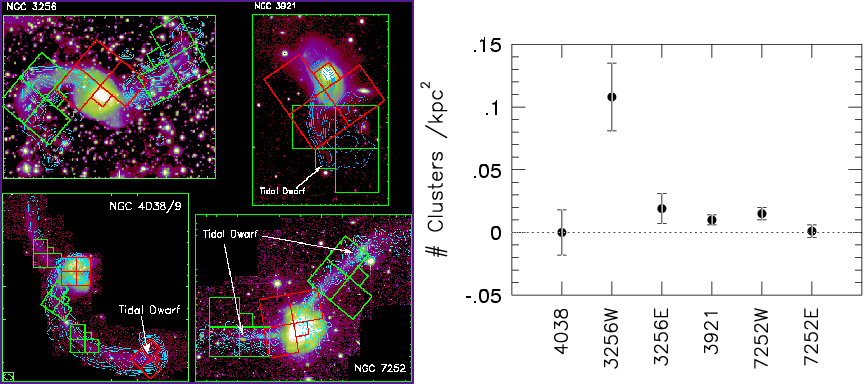
From Globular Clusters to Tidal Dwarfs: Structure Formation in
the Tidal Tails of Merging Galaxies
Knierman (Steward Obs), Gallagher (STScI,MIT),
Charlton (PSU), Hunsberger (PSU), Whitmore (STScI), Kundu (MSU),
Hibbard (NRAO) & Zaritsky (Steward Obs),
2003, The Astronomical Journal, 126, 1227
(pdf 6.3MB)
(ADS)
(astro-ph/0307383)
Using V and I images obtained with WFPC2/HST, we investigate compact
stellar structures within tidal tails. Six regions of tidal debris in
the four classic ``Toomre Sequence'' mergers: NGC 4038/39
(``Antennae''), NGC 3256, NGC 3921, and NGC 7252 (``Atoms for Peace'')
have been studied in order to explore how the star formation depends
upon the local and global physical conditions. These mergers sample a
range of stages in the evolutionary sequence and tails with and
without embedded tidal dwarf galaxies. The six tails are found to
contain a variety of stellar structures, with sizes ranging from those
of globular clusters up to those of dwarf galaxies. From V and I WFPC2
images, we measure the luminosities and colors of the star
clusters. NGC 3256 is found to have a large population of blue
clusters (0.2 < V-I < 0.9), particularly in its Western tail, similar
to those found in the inner region of the merger. In contrast, NGC
4038/39 has no clusters in the observed region of the tail, only less
luminous point sources likely to be individual stars. A significant
cluster population is clearly associated with the prominent tidal
dwarf candidates in the eastern and western tails of NGC 7252. The
cluster-rich Western tail of NGC 3256 is not distinguished from the
others by its dynamical age or by its total HI mass. However, the
mergers that have few clusters in the tail all have tidal dwarf
galaxies, while NGC 3256 does not have prominent tidal dwarfs. We
speculate that star formation in tidal tails may manifest itself
either in small structures like clusters along the tail or in large
structures such as dwarf galaxies, but not in both. Also, NGC 3256 has
the highest star formation rate of the four mergers studied, which may
contribute to the high number of star clusters in its tidal tails.
Related Links:
- Hibbard's page for NGC 3921
- Hibbard's page for NGC 4038/9
- SN2007sr in southern tail of NGC4038:
SNWeb,
Catalina Sky Survey
- Hibbard's page for NGC 7252
- An HI Threshold for Star Cluster Formation in
Tidal Debris, Maybhate, A., Masiero, J., Hibbard, J. E.,
Charlton, J. C., Plama, C., Knierman, A. & English, J.
2007, MNRAS, 381, 59
(astro-ph/0707.3582)
- The Stellar Content of the
Southern Tail of NGC 4038/9 and a Revised Distance,
I. Saviane, J.E. Hibbard, & R. M. Rich, 2004, AJ,
(Feb 2004; WFPC2 of TDG in NGC4038)
-
From Globular Clusters to Tidal Dwarfs: Structure Formation in
Tidal Tails
Charlton, Knierman, Hunsberger, Gallagher,
Whitmore, Kundu, & Hibbard in Celebrating 10 Years of
HST
(astro-ph/0009196)
-
From Globular Clusters to Tidal Dwarfs: Structure Formation in
Tidal Tails
Knierman, Hunsberger, Gallagher, Charlton,
Whitmore, Hibbard, Kundu, & Zaritsky, slide show from 2000 winter
meeting of AAS.
Last modified: Thu Oct 30 10:18:13 EST 2003
Back to home
Maintained by
jhibbard
@ nrao.edu
